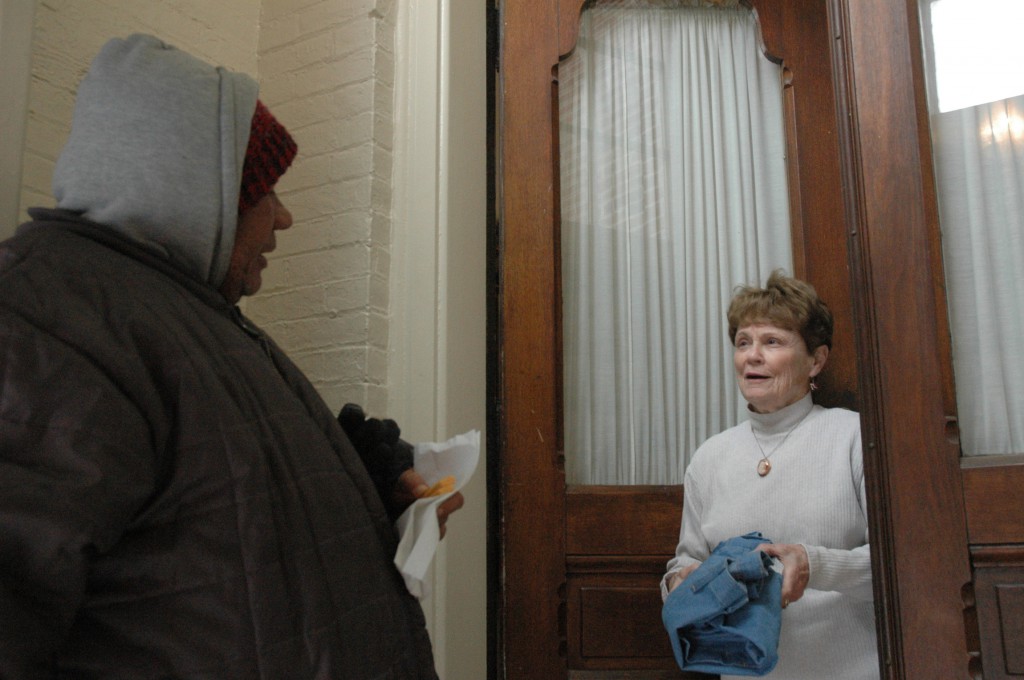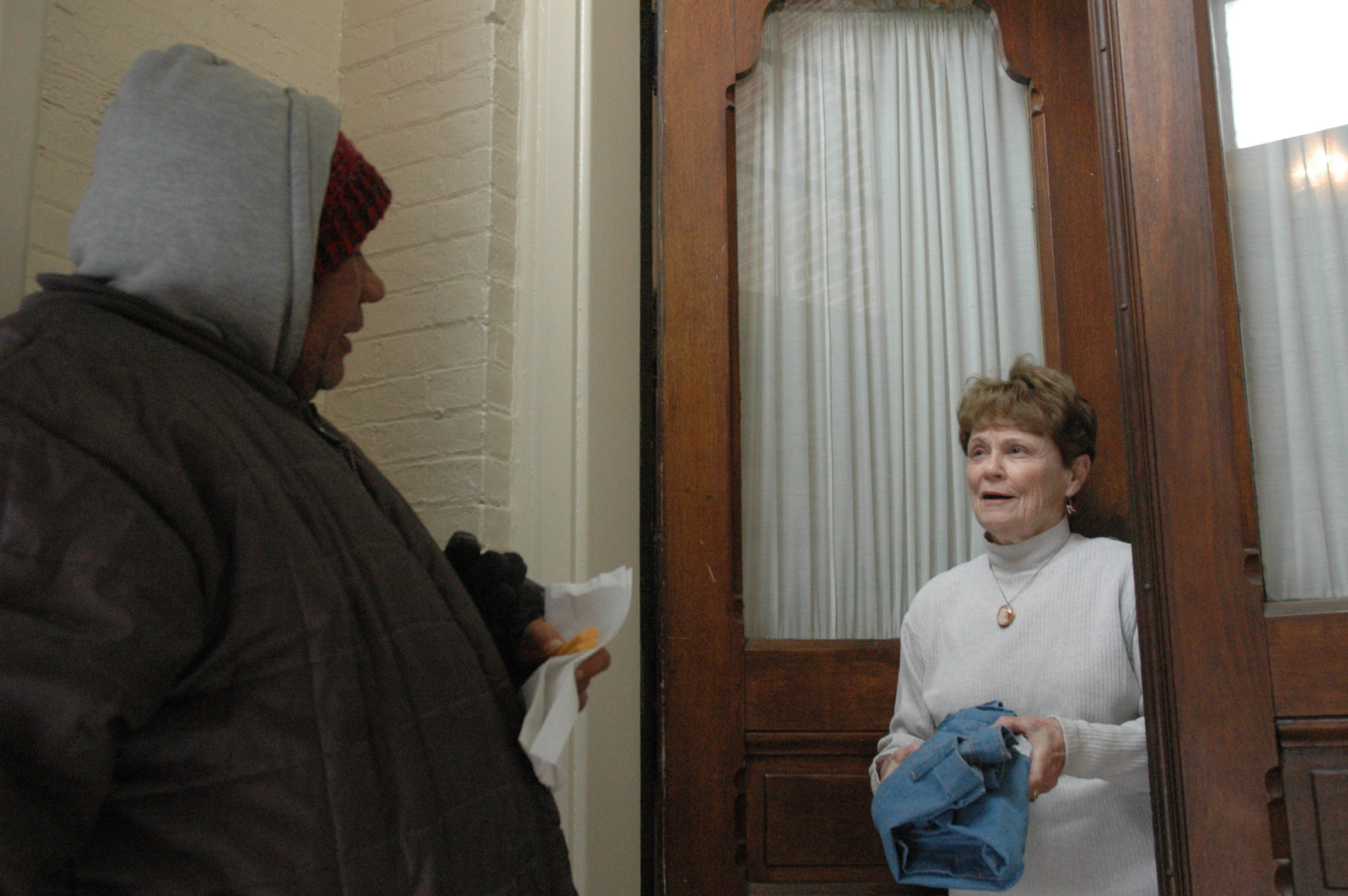
INDIANAPOLIS (CNS) — The doorbell rang on another bitter, below-zero-wind-chill day, letting Dave Bartolowits know there was another person in need shivering outside the rectory door of St. John the Evangelist Parish in downtown Indianapolis.
Bartolowits was nearing the end of his two-hour volunteer shift at the parish’s Garden Door Ministry, one that serves hot meals and provides warm clothing every weekday from 9 a.m. to 5 p.m. to the city’s homeless.
As he headed toward the door, the violinist for the Indianapolis Symphony Orchestra had just finished telling a story about a young man who recently approached him on a downtown street, asking for money for food.
“He was just wearing a sweatshirt, and he looked like he was having hypothermia,” Bartolowits recalled. “I told him that St. John’s was a place he could go for a hot meal, a coat, a hat and gloves — and I gave him directions. He clearly needed everything.”
The need for food, clothes and shelter has been constant in a brutal winter marked by soaring snow totals and dangerously plunging cold temperatures in Indiana.
Just as constant has been the Catholic response to that need, from the efforts of volunteers to the commitment of the Indianapolis archdiocesan Catholic Charities.
“We always try to provide a sandwich and water, but during this cold stretch of weather, we have been serving hot meals, thanks to the generosity of donors,” said Bartolowits, coordinator of the Garden Door Ministry. “We’ve served spaghetti, lasagna, chili and bean soup. There are times when we serve 70 meals a day.
“We also provide limited clothing. We have a room where we store coats, shirts, hats, pants. And we have some blankets we’re handing out, again thanks to the generosity of donors.”
The doors to the parish church are open into the evening, offering people a place to “stay warm, to pray, to get out of the weather,” Bartolowits told The Criterion, the archdiocesan newspaper.
“We’re trying to provide an atmosphere of hospitality for everyone who comes to our door. It’s a way to live out the call of Christ to serve our brothers and sisters.”
Sometimes the hospitality has led to a life change for homeless people, according to the parish’s director of catechesis and discipleship, Joshua Schaffner.
“It’s our hope to empower our neighbors to move on to the next stage of their lives — to find housing or employment or, in some cases, both,” Schaffner said.
Throughout the winter, the staff at Holy Family Shelter in Indianapolis has answered a steady flow of desperate calls from families seeking a place to stay.
“We say that homelessness doesn’t know a season. Unfortunately, homelessness doesn’t know a temperature either,” said Christina Davis, director of operations of the archdiocesan Catholic Charities shelter.
The huge snowfall amounts — about 28 inches in Indianapolis in January — have increased problems for the homeless.
Even with the challenges of weather, the Holy Family Shelter staff has kept a focus on helping its residents pursue job searches and explore housing options.
Efforts to help the homeless and other people in need are “building the kingdom of God,” said Andrew Costello, a member of St. Joan of Arc Parish in Indianapolis, who started an outreach program called Operation Leftover.
Its young adult volunteers regularly gather together and walk the streets of downtown Indianapolis to distribute blankets, hats, gloves and a few sleeping bags to homeless people with no place to go.
“There’s a lot of need out there, and we give people hope,” said Costello. “For those of us who have a warm place to live, there’s a hunger and a need to help people, to be good stewards of what we have. There are a lot of generous people who want to help.”
In Philadelphia’s center city, the Hub of Hope offers a refuge for the homeless suffering through the winter’s snow and freezing temperatures there.
Hub of Hope, which operates only in the winter months, provides services to the homeless men and women who congregate in the city’s Suburban Station concourse — an underground commuter rail station — as a shelter from the bitter weather.
At first glance, it just appears to be a place where the homeless can drop in, sit a while and drink endless cups of coffee or tea and cocoa if available. But it actually is a hub — where the homeless can go to be connected with various social services and shelters. Many of the regulars are shelter-resistant, emotionally unwilling to accept the services that can take them off the streets and out of the concourses.
“Some people are happy the way they are,” said coordinator Karen Orrick. “They refuse to go to shelters and have a long history in the system. But shelter is the most pressing need and there are not always sufficient beds to fill the need.”
Hub of Hope’s target population is the long-term homeless. It connects them with a place where they can get a meal, a hot shower and somewhere warm to spend the night.
Long-term housing is usually a process involving paperwork often beyond the capacity of the people who need it, and that is really Hub of Hope’s real mission. In addition to staff case managers such as Green, there are medical and psychiatric professionals who determine the need and can sign off on the paper work, as well as perform triage at the small clinic in the back of Hub.
“We are able to help most of the people who come here,” case manager Carmena Green told CatholicPhilly.com, the news website of the Philadelphia Archdiocese.
In the month of January, Orrick estimated there were about 1,000 visitors to the Hub, with about 500 of them first-timers.
“It’s fantastic, they are so accepting of everybody,” said Matt, a frequent visitor. “We have nothing and they share with us.”
— John Shaughnessy, Catholic News Service.







